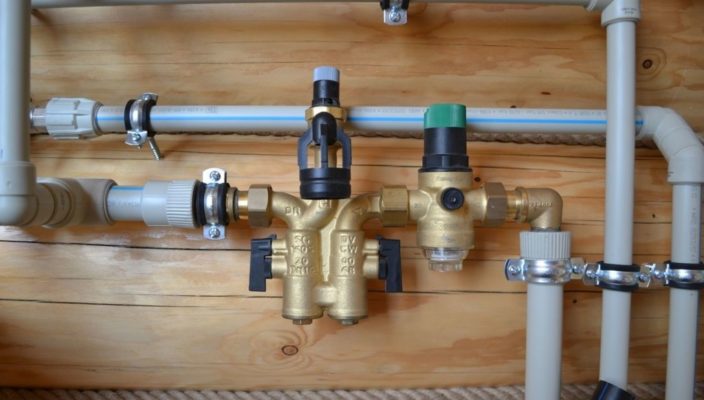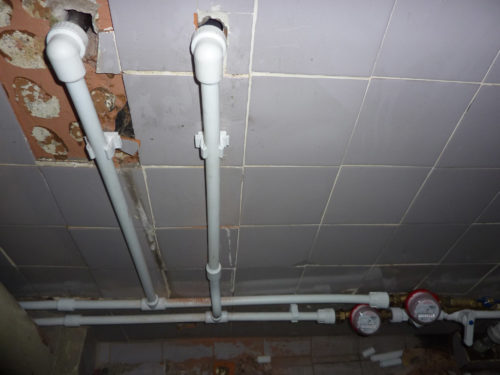It is difficult to present comfortable accommodation without daily water supply. To create a water supply system, use various materials. Our article we will talk about the features of the installation of water pipes from polypropylene.
Content
- Polypropylene Characteristics for Pipes
- The varieties of polypropylene tubes
- Component products for polypropylene pipes
- Preparatory stage of installation of polypropylene pipes
- Installation work on the laying of polypropylene pipes
- Nuances of polypropylene pipes
- Tips on the high-quality device of water pipes from polypropylene pipes
Polypropylene Characteristics for Pipes
More recently, tap lines stretched from steel pipes. Now a more practical solution is the use of plastic products. One of them is polypropylene tubes. They can be used when laying new lines, and when joining the old water supply.
Huge demand for polypropylene is due to its positive properties:
- absolute environmental friendliness;
- low weight (this is important when transporting and installing material);
- high resistance to aggressive medium;
- inconsistent of corrosion;
- long operational period (up to 50 years);
- the best tightness of the compounds (among plastic analogs);
- excellent sound absorption (moving water in the pipe is not heard at all);
- low hydraulic resistance;
- the presence of a wide range of components;
- the possibility of hidden gasket pipes;
- simplicity of installation work.
The only nuance is that it will have to take advantage of a special soldering iron with the nozzles of the appropriate size. Without it, it is impossible to carry out a high-quality solder of polypropylene.
The varieties of polypropylene tubes
The features of the range of polypropylene tubes lies with the technology of their manufacturing. Polypropylene is plastic, which is obtained by cracking petroleum products and gas propylene. The polymerization reactions occurs under high pressure using the catalyst.
For a water supply network, two types of polypropylene pipes are produced:
- single-layer;
- multilayer.
Single-layer material is designed for cold water. Pipes from several layers are designed to transport hot water. Their distinctive feature is the presence of additional material (fiberglass, polyethylene or foil) between polypropylene layers.
When purchasing pipes, pay attention to the marking of products. There are two labeling of water pipes.
First marking:
- RR-H - for cold water;
- PR-B is also for cold water (the main difference is increased resistance to mechanical loads);
- RR-R - for a water supply system with cold and hot water;
- PRS - for transportation of hazardous substances.
Second marking:
- Pn10 - for cold water with a temperature of up to + 20ºС;
- Pn16 - for cold and hot water with a temperature of up to + 60ºС;
- RN20 - for cold and hot water with a temperature of up to + 80ºС;
- Pn25 (reinforced by aluminum foil) - for cold and hot water with a temperature of up to + 95ºС.
When choosing pipes, internal and external dimensions take into account. The diameter can be in millimeters or inches. The outer diameter of products is 1.6-50 cm, the length of 2-5 m. Depending on the diameter of the pipes, the soldering iron nozzles will be seamless.
Component products for polypropylene pipes
The range of components for pipes from polypropylene is distinguished by a variety. All items have different sizes and shapes. It is recommended that the firm-producer of pipes and components to them be the same.
The main components are:
- couplings;
- adapters;
- corners;
- crosses and tees;
- opports.
Polypropylene pipe clutches are an element that connects two adjacent pipes. For this reason, the inner diameter of the coupling must coincide with the size of the pipe.
In the form of adapters similar to couplings. A distinctive feature is opposite ends with a different internal cross section. The main purpose of adapters is to connect pipes of different sizes. Adapter for pipes from polypropylene can be a thread (both external and internal).
Polypropylene pipes are used in places of rotation of the plumbing network. The ends of these components can have both holes and external or internal threads. Corners can be single or double.
Purpose of crossbars and tees for polypropylene pipes - simultaneous compound 3-4 pipes. Accessories are of different sizes, with threads without it, under various types of pipes.
If there is an obstaclecy obstacle network in the path, structures for polypropylene pipes are used. They are bending from plastic. When laying the taps, two main rules should be followed:
- The distance from the pipes to the wall should be minimal.
- Neighboring the pipes should be straight.
In addition to these main components, for a high-quality device of the water supply, you must purchase:
- ball Valves;
- plugs (for overlapping unused branches);
- clamps (for fixing pipes to the wall).
Preparatory stage of installation of polypropylene pipes
At the start stage, the question arises where to start installing pipes from polypropylene. Experts recommend first to make a plan-scheme of the future water supply with an indication of all consumers. The most optimal location of the entire plumbing and household appliances should be determined.
Immediately it is necessary to determine the type of wiring, which is 2 species:
- consistent;
- collector.
The first type of wiring provides for a sequential connection of all consumers of water. The advantage of this technology is to use the minimum number of pipes and components. The disadvantage is a different water pressure (the farther from the starting point of the water supply, the worse the pressure).
The collector wiring establishes a distribution unit, distributing aqueous streams and guiding water to a specific point of water intake. The advantage of this method is the same pressure throughout the water supply system, disadvantage - the creation of a separate branch for each consumer (this will increase the amount of consumable material).
At the initial stage, the method of laying pipes is selected. It can be both hidden and open. Naturally, the first option is more aesthetic. The purchase of pipes and components is carried out with a small margin.
When designing, it is necessary to reduce the length of the new water supply, and make the minimum number of turns and joints. This is due to the fact that it is in these places that there is a high probability of leakage. Moreover, the presence of a large number of turns leads to a decrease in pressure in the water supply system.
Installation work on the laying of polypropylene pipes
The gasket of the tap line starts with the places where consumers will connect. In these places, adapters with carvings and ball valves are mounted to disconnect the plumbing from the general system in the case of repair work.
Depending on the type of wiring from consumers, the pipes are drawn to the collector or the next consumer. When performing installation work, the distance between the pipe and the wall should exceed 2 cm. The screwing step of the clamp is 1-1.5 m (in addition, the clamps are attached in each corner and turns).
Special attention is paid to the laying of the pipeline through the walls and partitions. The pipe is necessarily placed in a special glass, which acts as a protective barrier from mechanical load. It is recommended that the minimum number of pipes takes place through the wall (one is best). In the presence of drain cranes, the installation of pipes is carried out with a slight bias in their direction.
Each pipe branch is connected to a collector with mandatory installation of shut-off elements. After that everything is going to one system.
The autonomous water supply system consists of such elements;
- the initial point of the insertion is a well, a well or other source of water intake;
- water meters;
- watering line in the trench on the street (in the northern regions it is recommended to inspire);
- tube entrance to a private house;
- coarse filter (mounted on the inside of the house);
- additional filters in front of plumbing and household appliances (if necessary, but necessarily in front of the washing machine and the mixer in the kitchen).
For the transportation of warm water into the kitchen after the filter, a tee is mounted, which is designed to distribute water along two branches: hot and cold. The pipe, which comes with cold water, connects with "its" collector. The hot water branch should be connected to the boiler.
Nuances of polypropylene pipes
Now about how to connect polypropylene pipes. For these purposes, a special soldering iron with nozzles is used.
The process of soldering pipes implies the following actions:
- pipe measurements are made to connect;
- pipes are cut by special scissors;
- the soldering iron is mounted nozzles of the required size (must correspond to the diameter of the pipes);
- the soldering iron is heated to a temperature of 250-270ºС;
- pipe and fitting dressed on heated nozzles and are held within 6-12 seconds (time depends on the thickness of the elements);
- after heating, the fitting and pipe are removed from the nozzles and are connected to each other (without rotational motion);
- pressed elements are held for 30-40 seconds (plastic should be well frozen).
The sign of a qualitatively performed process is the presence of a uniform bilk on the circumference of the pipe. Such a bin tests about the normal heating of all parts of the fitting and the pipe. The height of the bureau should be the same throughout the circumference. In place with a minimum height, there is a high probability of leakage.
Tips on the high-quality device of water pipes from polypropylene pipes
When soldering and laying polypropylene pipes, it is not recommended to make mistakes. This is especially true of the hidden water supply, when the bill of errors can be to carry out new repairs.
There are such typical errors when installing the pipeline:
- Polypropylene is forbidden to bend. On the outer surface of the curved pipe, the wall becomes very thin. This will lead to a significant reduction in the pipeline of the pipe.
- The use of low-quality soldering nozzles. Nozzles are covered with teflon, which does not allow plastic sticking. Over time, on the nozzles, the Teflon layer becomes thin, and sometimes disappears. It is fraught with sticking plastic during soldering, resulting in a poor-quality connection of the pipe with fitting.
- The presence of moisture and dirt on the details connected. Fittings and pipes before soldering is recommended to wipe on a rag in welding places. Especially fatal can be the presence of water. When soldering moisture turns into a pair that deforms the material.
- Embossed foil removal from the pipe. The presence of even a small piece of foil at the site of the soldering worsen the quality of the connection.
- Removal of bulbs (appear with excessive overheating of nozzles) with polypropylene directly during welding. Plastic should be frozen, otherwise the removal of defects is fraught with deformation of the surface of the elements.
- Connection of pipes and components of various manufacturers. This should not be done even in the case of soldering high-quality products of well-known companies. This is explained by the plastic may differ in chemical composition. When heated, plastic parts can be connected in different ways.
- Failure to comply with elementary editing rules. These include insufficient introduction of the pipe in the fitting, applying an excessive effort when putting a preheated end of the pipe or soldering the fitting of the jack with a pipe (if fitting damage).
- The absence of a threaded connection at the points of placement of water consumers. And for the entire plumbing, the coupling must have an external thread. Only under the mixer in the shower or bathroom will require accessories with internal threads.
Useful video on the installation of polypropylene pipes:

























